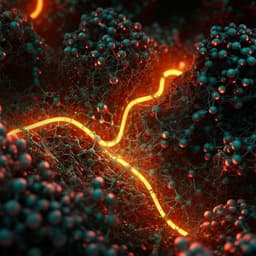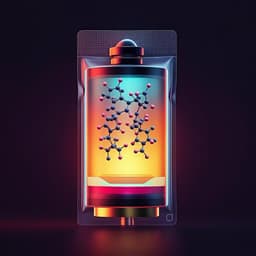
Engineering and Technology
Room temperature all-solid-state lithium batteries based on a soluble organic cage ionic conductor
J. Li, J. Qi, et al.
Discover how a pioneering class of porous organic cages is revolutionizing solid-state lithium batteries by creating effective ionic conduction pathways. This groundbreaking research conducted by Jing Li, Jizhen Qi, Feng Jin, and others, showcases a novel catholyte that enhances the performance of batteries at room temperature, propelling the future of energy storage.
~3 min • Beginner • English
Introduction
The study addresses a critical challenge in all-solid-state lithium batteries (SSLBs): establishing efficient Li+ transport networks within solid-state cathodes, especially for thick electrodes with practical areal loadings. While significant progress has been made in solid-state electrolytes (SSEs) and interface engineering, Li+ transport inside the cathode remains less resolved. Existing strategies include: (1) adding liquid/ionic liquid/plastic crystal electrolytes, which compromises long-term stability and safety due to narrow electrochemical windows and decomposition; (2) incorporating insoluble inorganic SSE particles (e.g., LLZO, LGPS), which often aggregate, require high loadings (20–60 wt%), and suffer from poor solid–solid contact; and (3) using polymer electrolytes that typically have low room-temperature conductivity and narrow electrochemical windows. Consequently, many room-temperature SSLBs show limited cycle life or require high SSE fractions and complex fabrication. The authors propose a soluble porous organic cage (POC)-based Li+ conductor as a catholyte to create continuous ion-conducting pathways in cathodes via conventional slurry processing, aiming to reduce additive content while achieving strong room-temperature performance.
Literature Review
The paper surveys three main strategies for enabling Li+ transport in solid cathodes: (1) embedding liquid or plastic crystal electrolytes into porous cathodes, which can initially yield good ion transport but suffer from decomposition and SEI/CEI formation, leading to capacity rollover; (2) adding inorganic SSEs (e.g., LLZO, LGPS) as catholytes, which are insoluble and aggregate, necessitating high loadings (20–60 wt%) and incurring high interfacial resistance due to poor ceramic–active material contact; (3) incorporating polymer electrolytes, which often exhibit narrow electrochemical windows and low room-temperature conductivities. Prior porous solids like MOFs and COFs have been explored for ion conduction but are extended, insoluble frameworks. Discrete, soluble porous organic cages (POCs) offer processability and tunable properties; previous work demonstrated proton conduction in amine cages. However, no prior Li-ion conductors based on POCs had been reported before this work.
Methodology
Materials and synthesis:
- RCC1 cage synthesis: RCC1 prepared by reductive amination of ethylenediamine with 1,3,5-triformylbenzene in methanol, followed by NaBH4 reduction, extraction, and purification (overall 42% yield). RCC1 was protonated with HCl in dioxane to form RCC1-Cl (71% yield).
- Ion exchange to RCC1-ClO4: RCC1-Cl dispersed in 15 wt% LiClO4 in ethyl acetate at 50 °C with periodic solution refresh to exchange counterions to perchlorate; product collected and washed (60% yield).
- Formation of Li-RCC1-ClO4 SSE: RCC1-ClO4 blended with LiClO4 in ethanol/water (v:v 3:1 typical), solvent removed; targeted molar ratio [Li+]/[−NH2+−] ≈ 1:1 optimized.
Characterization:
- Morphology: SEM showed sub-micron particles forming fluffy aggregates; FIB-SEM cross-sections examined cathode architecture.
- Composition and bonding: EDX mapping verified uniform LiClO4 dispersion; XPS Cl 2p confirmed conversion from Cl− to ClO4− and presence of weakly coordinated vs free perchlorate in Li-RCC1-ClO4; Raman spectra deconvolution (915–950 cm−1) quantified perchlorate environments (~82% free, ~18% weakly coordinated). FTIR and PXRD assessed phase/crystallinity in cathodes.
- Thermal stability: TGA showed decomposition onset >220 °C under N2.
Electrochemical measurements:
- Ionic conductivity: EIS (0.01 Hz–7 MHz, 10 mV AC) on Au-blocking-electrode symmetric cells; conductivity calculated as σ=L/(R·S). Temperature dependence and Arrhenius analysis yielded activation energy.
- Electrochemical stability window: LSV (0–6 V vs Li/Li+ at 1 mV s−1) with Au working electrode and Li reference/counter.
- Li+ transference number: DC polarization (50 mV) combined with EIS before/after polarization using Li–carbon composite non-blocking electrodes; tLi+ computed by standard Bruce–Vincent method.
Cathode fabrication and cell assembly:
- Cage solubility: Demonstrated solubility in water, methanol, DMF, NMP, ethanol, acetonitrile, acetone, THF, enabling slurry processing.
- LiFePO4 (LFP) solid-state cathode composition: LiFePO4: acetylene black: CNTs: PVDF: Li-RCC1-ClO4 = 71:4:2:3:20 (wt%). Solvent: methanol/NMP (1:1 v/v). Slurry cast on Al foil, dried at 80 °C, roll pressed. Areal loadings 1–4 mg cm−2 studied; densities 1.24–4.96 g cm−3.
- Comparative cathodes: (i) without cage catholyte; (ii) PEO/LiClO4 catholyte (LiFePO4:AB:CNTs:PEO/LiClO4 = 71:4:2:23).
- Separator/SSE for full cells: polymer P(IL-PEGDA) (~80–100 µm) prepared by UV photopolymerization of ionic liquid monomer and PEGDA with LiTFSI; dried to remove solvent. For LLZO-based cells, thin P(IL-PEGDA) interlayer on LLZO (300 µm polished) toward Li anode; cathode slurry cast on other side.
- Additional cathodes: NCM523 and LCO with composition 74:2:1:3:20 (active:AB:CNTs:PVDF:Li-RCC1-ClO4); high-voltage SSE layer between cathode and anode was a polymerized system stable >4.5 V.
Structural and spatial distribution in electrodes:
- SEM/EDX mapping showed Fe (LFP) particle shapes surrounded by N and Cl signals from the cage, indicating recrystallization on particle surfaces forming an ion-conducting network.
- TOF-SIMS 3D imaging and depth profiling: PO3− (LFP) and CN−/ClO3− (cage) signals complementary throughout thickness, confirming homogeneous distribution. Post-cycling cross-sectional EDX showed no S (from polymer electrolyte) diffusion into cathode.
Electrochemical testing protocols:
- Coin cells (CR2025) with Li metal anode, P(IL-PEGDA) SSE, and cathodes as above; cycling at room temperature (25 ± 3 °C) at various C-rates (0.1–1 C) and elevated temperature (60 °C) for rate studies. EIS equivalent circuit deconvolution using symmetry cells (SS|SSE|SS; Li|SSE|Li) to attribute resistive elements.
Key Findings
- First Li-ion solid-state electrolyte based on a porous organic cage (Li-RCC1-ClO4) without solvent.
- Optimized composition: [Li+]/[−NH2+−] ≈ 1:1.
- Ionic conduction properties of Li-RCC1-ClO4 SSE:
- Room-temperature ionic conductivity: 5.13 × 10−5 S cm−1; reaches 1.2 × 10−4 S cm−1 at 60 °C.
- Activation energy: 0.34 eV.
- Electrochemical stability window: up to 5.0 V vs Li/Li+.
- Li+ transference number: ~0.7.
- Thermal stability: decomposition onset >220 °C.
- Raman/XPS indicate high fraction of free perchlorate (~82%), consistent with strong Li-salt dissociation.
- Processing advantage: Soluble cage recrystallizes during drying to coat and interconnect cathode particles, forming continuous ion pathways with only 20 wt% additive (vs 30–60 wt% typical inorganic SSEs).
- Cathode ionic conductivity (LFP-based): average ~4.64 × 10−5 S cm−1 with 20 wt% Li-RCC1-ClO4; ~5.06 × 10−5 S cm−1 with 30 wt%.
- Full-cell performance at room temperature (P(IL-PEGDA) SSE):
- LFP cathode (~1 mg cm−2): initial specific capacity ~147 mAh g−1 at 0.1 C with ~3.4 V plateau; stable cycling with ~152 mAh g−1 and ~100% coulombic efficiency; markedly reduced polarization vs controls.
- Controls: without cage (~52 mAh g−1, ~530 mV polarization); with PEO/LiClO4 catholyte (~65 mAh g−1, ~700 mV polarization).
- EIS total impedance: with cage ~468 Ω cm2; without cage ~992 Ω cm2; with PEO/LiClO4 ~1737 Ω cm2.
- Cathode|SSE interfacial resistance (fitted): with cage ~255 Ω cm2; without cage 785 Ω cm2; with PEO/LiClO4 1520 Ω cm2.
- Rate and long-term cycling:
- LFP at 0.5 C: 122–135 mAh g−1 for 200 cycles; coulombic efficiency approaches ~100% after initial cycles.
- LFP at 1.0 C: 88.2% capacity retention at 750 cycles (~0.026% decay per cycle); cathode morphology preserved post-cycling.
- Areal loading effects:
- Similar 0.1 C cycle life at 2–4 mg cm−2; rate capability decreases with higher loading, attributed to Li anode surface degradation (coarse/fluffy Li) and poor solid–solid contact at higher areal capacities.
- At 60 °C and 0.5 C (2 mg cm−2): ~135 mAh g−1 with stable cycling; at RT and 0.5 C: ~90→115 mAh g−1 over cycles.
- Compatibility with other cathodes:
- NCM523 (to 4.3 V): initial 165 mAh g−1; 81.8% retention after 60 cycles.
- LCO (4.3–4.4 V): good cycling stability at 0.2 C.
- Transferability: With LLZO ceramic SSE, adding the cage catholyte to the cathode enabled ~130 mAh g−1 vs negligible capacity without cage.
Discussion
The soluble porous organic cage catholyte (Li-RCC1-ClO4) directly addresses the challenge of establishing efficient Li+ transport within solid-state cathodes. Its discrete molecular nature enables dissolution in common polar solvents and uniform mixing in slurries, followed by recrystallization on active material surfaces to form continuous Li-ion pathways. This solution processability overcomes dispersion/aggregation issues of insoluble ceramic SSE particles, enabling effective percolation with only 20 wt% additive and preserving energy density. The cage’s ionic environment promotes Li-salt dissociation (high fraction of free anions), yielding favorable room-temperature conductivity, a wide electrochemical window (5.0 V), and a high Li+ transference number (~0.7), supporting use with higher-voltage cathodes (NCM523, LCO). Electrochemical results demonstrate significantly reduced cathode interfacial resistance and total impedance, enhanced utilization of active material, low polarization, and long-term cycle stability, including at higher rates (up to 1 C) and with thicker electrodes. The approach is compatible with industrial slurry coating and transferable across different SSE frameworks (polymer and ceramic). Remaining performance limitations at higher areal capacities are linked to Li metal anode interfacial issues rather than cathode ion transport, suggesting future optimization of the anode/SSE interface to fully exploit the cathode improvements.
Conclusion
This work introduces Li-RCC1-ClO4, the first solvent-free porous organic cage-based Li-ion solid electrolyte and an effective, solution-processable catholyte for solid-state cathodes. The cage offers room-temperature ionic conductivity (5.13 × 10−5 S cm−1), a wide electrochemical window (to 5.0 V), and a high Li+ transference number (~0.7). Its solubility enables uniform slurry processing; upon drying, the cage recrystallizes to coat and interconnect active particles, forming a continuous Li-ion conduction network with only 20 wt% additive. SSLBs with LFP, NCM523, and LCO cathodes show low polarization, reduced interfacial resistance, and strong room-temperature and elevated-temperature cycling, including long-term stability at 1 C and functionality with ceramic SSEs (LLZO). The approach is fully compatible with existing cathode manufacturing. Future research should target improved air/moisture stability, enhanced mechanical robustness, and higher ionic conductivity via molecular design of cages and related organic additives, and integrate anode/SSE interface engineering to support higher areal capacities and rates.
Limitations
- Although cathode ion transport is improved, rate performance declines at higher areal loadings (e.g., 3–4 mg cm−2) due to Li metal anode issues (coarse/fluffy Li deposition and poor solid–solid contact), indicating the anode/SSE interface remains a bottleneck.
- The cage SSE’s room-temperature ionic conductivity (≈5 × 10−5 S cm−1) is moderate compared with top-performing inorganic sulfides, potentially limiting extreme-rate operation without thermal assistance.
- PXRD indicates reduced crystallinity of the cage after slurry coating; while beneficial for coating formation, structural changes may influence long-term stability and reproducibility.
- Air/moisture stability and mechanical properties of the cage electrolyte require further improvement, as acknowledged by the authors.
- Optimal performance was achieved with a polymer SSE separator (P(IL-PEGDA)); broader compatibility with other separators and stack designs needs further verification.
Related Publications
Explore these studies to deepen your understanding of the subject.







